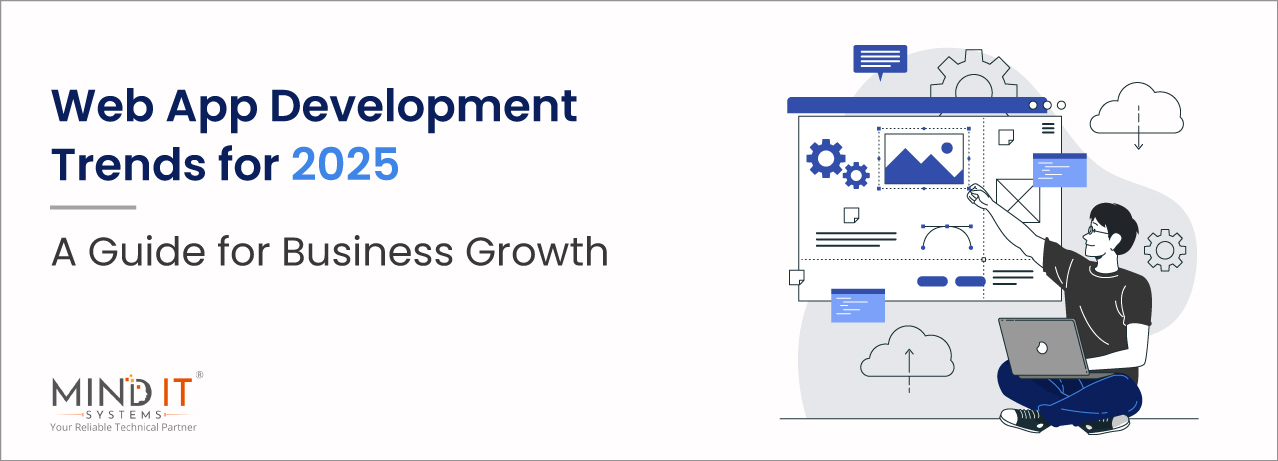
Web App Development Trends for 2025: A Guide for Business Growth
Introduction
The world of web app engineering is unfolding quicker than ever, and 2025 is set to be a landmark year for ventures eyeballing to harness the power of tech. As digital landscapes transform, staying in advance of the curve is not only a choice — it is a requirement. From AI-driven insights to the upward thrust of innovative web apps, those traits are reshaping how companies operate and unlocking new avenues for growth.
Imagine growing web applications that predict your customers’ needs, scale seamlessly together with your enterprise, and supply exquisite user reviews — that is the capability of 2025’s web application developments. In this guide, we will take you through the imperative improvements, why they are counted, and how you could prepare your business to thrive in this era of innovation.
Let’s dive in and find out the future for web app development.
Why do Web App Development Trends Matter for Businesses?
Why should businesses care about web app development trends? It’s simple: they hold the key to future-proofing your operations. From enhancing scalability to engaging users with cutting-edge solutions, staying updated ensures you meet customer expectations while outpacing competitors in a fast-evolving landscape.
Key Web App Development Trends for 2025
What’s in store for web app development in 2025? A dynamic landscape of innovation and user-focused advancements! Join us as we explore the key trends that every business, regardless of size, needs to know.
1. AI and Machine Learning Integration
AI is reshaping web app development, making solutions smarter and more efficient. What can businesses expect in 2025?
- Customized Experiences: AI will personalize content and recommendations for users, improving engagement.
- Smarter Chatbots: AI chatbots will handle customer queries faster and more effectively.
- Effortless Automation: Routine tasks? Let AI handle them so your team can focus on what matters most.
2. Progressive Web Apps (PWAs)
Progressive web apps (PWAs) are the future of web development integrating the power of web and mobile apps to deliver:
Enhanced Speed and Offline Access: Faster load times and offline functionality make certain reliability for users.
Cost Savings: A single PWA can serve a couple of platforms, lowering development and upkeep charges.
Higher Retention Rates: Features like push notifications and short performance drive regular user engagement.
3. Low-Code and No-Code Development
Low-code and no-code platforms are rebuilding how web apps are built, making app development accessible to all:
- Simplified Development: These platforms allow non-technical users to build web apps without extensive coding knowledge.
- Faster Time-to-Market: Businesses can launch apps quickly and efficiently with minimal development effort.
- Popular Tools: Platforms such as Bubble and OutSystems are overriding the way, allowing great application buildout.
4. Cloud-Native Web Apps
Cloud technology is leading the charge in web development innovation:
- Scalability Made Easy: Handle business growth without infrastructure bottlenecks.
- Cost Savings: Only pay for what you need when needed.
- Collaboration Revolutionized: Centralized access improves efficiency and teamwork.
5. Security and Privacy Trends
With accelerating concerns around cybersecurity, organizations need to give priority to security measures in web app development:
- Advanced Encryption and Multi-Factor Authentication: These measures assure that information is protected, and only authorized users have the privilege of access.
- Data Protection Compliance: Adopting changing privacy regulations inclusive of GDPR and CCPA is crucial for maintaining user trust.
- Proactive Security Measures: Executing strong safety frameworks, corporations should live ahead of rising cyber threats.
6. Voice Search Optimization
Voice search is quickly turning into a designated technique for users to interact with apps. Upgrading for voice search is critical for staying relevant:
- Voice-Enabled Navigation: Voice search aids hands-unfastened interaction with web apps, driving ahead accessibility and convenience.
- Hands-Free Solutions: As voice tech grows in popularity, users increasingly prefer apps that offer voice commands.
- Integration with Smart Devices: Voice search capabilities ensure web apps work seamlessly with voice-activated devices like smart speakers.
7. Cross-Platform Compatibility
In today’s multi-device world, creating an unblemished app experience across all platforms is vital:
- Unified User Experience: From web to mobile to desktop, delivering a consistent experience is vital for user satisfaction.
- Frameworks for Efficiency: Platforms like React Native and Flutter empower developers to easily craft cross-platform apps with great quality.
- Saving Resources: Cross-platform development gives the perfect balance of time efficiency and budget-conscious solutions without sacrificing app performance.
8. Sustainability in Web Development
Sustainability is no longer just a buzzword—it’s an imperative factor in modern web development approaches:
- Energy-Efficient Coding: Optimizing code to run more efficiently can significantly reduce energy consumption.
- Choosing Green Data Centers: Hosting web apps on sustainable, eco-friendly data centers helps lower the overall carbon emissions of web development.
- Simplicity in Design: Creating minimalistic web apps with streamlined features helps minimize energy consumption, reduce resource use, load times thereby contributing to sustainability in web application development.
Preparing Your Business for 2025 Trends
Businesses must start preparing today to gain from the upcoming web app development tides. The first step is to assess your current tech stack and identify areas that need improvement or innovation—grip agile methodologies to adapt quickly to new trends and technologies.
Investing in the right talent, tools, and frameworks will keep you ahead of the competition. For example, explore cloud services, machine learning libraries, and no-code platforms that will enable faster, smarter development. Hence choosing the right web development tech stack is critical – so how to choose the right web development tech stack – A trustworthy technical partner can help you to care for your technical needs. It makes sure that you put in force those solutions successfully, streamline your processes, and owe the expertise required to stay beforehand.
Also, fostering a non-stop learning culture will make sure your team remains updated with contemporary enterprise developments, ultimately assisting your commercial enterprise to thrive in 2025.
Tools and Frameworks to Watch in 2025
The tools and frameworks software engineers use in web application development define the efficacy and success of their projects. As 2025 advances, staying updated with emerging technologies is vital for enterprises aiming to smoothen development and deliver superior user experiences. The future of web development looks promising, from AI-driven frameworks to advanced PWA solutions.
#1 AI and Machine Learning Tools
The role of AI in web development is undebatable. Tools like TensorFlow, PyTorch, and Dialogflow simplify and impact AI implementation for companies. These platforms allow software developers to integrate predictive analytics, intelligent automation and personalized user experiences into their web applications, giving businesses a competitive edge.
#2 Advanced Web Programming
PWAs are renewing user experience with speed, offline capabilities, and ease of use. Frameworks like Angular, React, and Vue.js are perfect for powerful PWAs that bridge the gap between web and mobile apps. This framework empowers developers to create fast, engaging, and easy-to-maintain apps.
#3 Low-Code and No-Code Platforms
Low-code, no-code platforms like OutSystems, Bubble, and Appian are game-changers for businesses looking to accelerate development timelines. These platforms enable non-technical users to design and deploy functional web applications quickly. Reduce reliance on extensive coding expertise while saving time and resources.
#4 Cloud-Native Development Tools
The cloud hangs on to be the backbone of scalable and flexible web applications. Platforms like AWS, Microsoft Azure, and Google Cloud represent the tools for cloud-native development and ensure high availability, improved performance, and low cost. These tools make it easy to manage and use resources when you want, adapting to your business growth.
#5 Security-Focused Frameworks and Tools
As cybersecurity cases grow, there is an increasing necessity for tools that epicenter on protecting applications. Frameworks like Spring Security and tools like Auth0 and Okta provide comprehensive authentication and encryption solutions. They help businesses erect trust with users by maintaining data privacy and compliance. Hence, being aware of the effective strategies and best practices for strengthening web applications security is essential for companies. As it can help to stay ahead of the emerging threats and protect user data.
#6 Plan for cross-platform development
Having apps that work uniformly across devices is necessary for delivering a consistent user experience. With frameworks such as Xamarin, React Native, and Flutter, developers can build apps that run smoothly on desktop, mobile, and web. This approach ensures reliability, saves time, and reduces development costs.
#7 Sustainable Development Tools
With sustainability at the forefront, tools, and practices that support eco-friendly development gain traction. Hosting solutions like GreenGeeks and energy-efficient coding frameworks help businesses to deliver high-performance apps and reduce their carbon footprint.
By being informed and holding upon the right tools and practices, organizations will be able to set themselves as leaders in their industries. These solutions not just make development more efficient; They help deliver a better user experience, optimize costs, and ensure long-term flexibility.
Industry-Specific Use Cases
Ecommerce
AI is transforming how businesses engage with customers and optimize the shopping experience. One real-world example is Amazon’s personalized recommendation engine. By leveraging machine learning algorithms, Amazon analyzes users’ browsing history, purchase behavior, and preferences to suggest products that are highly likely to resonate with individual customers. This personalized approach improves the shopping experience and drives conversion rates and sales.
Healthcare
AI is also making strides in diagnostics. A great example is PathAI, a company leveraging machine learning to analyze pathological images and assist doctors in diagnosing diseases like cancer more accurately and quickly. Integrating AI with cloud-based patient portals allows healthcare providers to offer faster, more accurate diagnoses, leading to better patient outcomes and streamlined operations.
Finance
In finance, the integration of blockchain technology is revolutionizing transaction security and transparency. One noteworthy example is JPMorgan’s Quorum, a permissioned blockchain platform that facilitates secure, transparent financial transactions. Using blockchain to track and verify transactions, financial institutions can reduce fraud, lower costs, and increase trust between parties.
FAQs On Web App Development Trends
Q: Why are PWAs important for businesses?
Answer: They give offline functionality, faster load times and cost savings over native applications.
Q: What role does AI play in improving web app user experience?
Answer: AI enhances user experience by personalizing content, automating tasks, and providing smarter customer support through chatbots. It helps businesses understand user behavior and preferences, enabling more intuitive and engaging web apps.
Q: What is the biggest challenge in embracing these trends?
Answer: Validate seamless integration with existing systems while maintaining security.
Conclusion
2025 is shaping up to be a transitional year for web development. By embracing trends such as AI integration, PWA and continuous improvement, businesses can achieve unprecedented growth when competing. Now is the time to plan, invest and innovate.
Share this post
About the Author

Sujoy Roy
(Head – Digital Marketing)
From my teenage time, I had a quench to solve problems and loved leadership. Starting my career in relation management, ignited my passion for managing people. While managing I realized technology needs to be incorporated to keep pace with the changing world & do my work efficiently.

